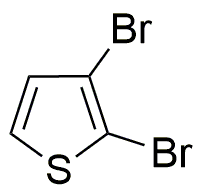2,3-Dibromothiophene is widely utilized in research focused on:
- Organic Electronics: This compound is a key building block in the synthesis of organic semiconductors, which are essential for developing flexible and lightweight electronic devices such as OLEDs and solar cells.
- Pharmaceutical Development: It serves as an intermediate in the synthesis of various pharmaceuticals, particularly in creating compounds with antimicrobial and anti-inflammatory properties.
- Material Science: Used in the formulation of advanced materials, 2,3-Dibromothiophene enhances the conductivity and stability of polymers, making it valuable in the production of high-performance coatings and composites.
- Research in Photovoltaics: This chemical plays a significant role in the development of new materials for solar energy conversion, contributing to more efficient and cost-effective solar cells.
- Analytical Chemistry: It is utilized as a reagent in various analytical techniques, helping researchers to detect and quantify other compounds effectively.
General Information
Properties
Safety and Regulations
Applications
2,3-Dibromothiophene is widely utilized in research focused on:
- Organic Electronics: This compound is a key building block in the synthesis of organic semiconductors, which are essential for developing flexible and lightweight electronic devices such as OLEDs and solar cells.
- Pharmaceutical Development: It serves as an intermediate in the synthesis of various pharmaceuticals, particularly in creating compounds with antimicrobial and anti-inflammatory properties.
- Material Science: Used in the formulation of advanced materials, 2,3-Dibromothiophene enhances the conductivity and stability of polymers, making it valuable in the production of high-performance coatings and composites.
- Research in Photovoltaics: This chemical plays a significant role in the development of new materials for solar energy conversion, contributing to more efficient and cost-effective solar cells.
- Analytical Chemistry: It is utilized as a reagent in various analytical techniques, helping researchers to detect and quantify other compounds effectively.
Documents
Safety Data Sheets (SDS)
The SDS provides comprehensive safety information on handling, storage, and disposal of the product.
Product Specification (PS)
The PS provides a comprehensive breakdown of the product’s properties, including chemical composition, physical state, purity, and storage requirements. It also details acceptable quality ranges and the product's intended applications.
Certificates of Analysis (COA)
Search for Certificates of Analysis (COA) by entering the products Lot Number. Lot and Batch Numbers can be found on a product’s label following the words ‘Lot’ or ‘Batch’.
*Catalog Number
*Lot Number
Certificates Of Origin (COO)
This COO confirms the country where the product was manufactured, and also details the materials and components used in it and whether it is derived from natural, synthetic, or other specific sources. This certificate may be required for customs, trade, and regulatory compliance.
*Catalog Number
*Lot Number
Safety Data Sheets (SDS)
The SDS provides comprehensive safety information on handling, storage, and disposal of the product.
DownloadProduct Specification (PS)
The PS provides a comprehensive breakdown of the product’s properties, including chemical composition, physical state, purity, and storage requirements. It also details acceptable quality ranges and the product's intended applications.
DownloadCertificates of Analysis (COA)
Search for Certificates of Analysis (COA) by entering the products Lot Number. Lot and Batch Numbers can be found on a product’s label following the words ‘Lot’ or ‘Batch’.
*Catalog Number
*Lot Number
Certificates Of Origin (COO)
This COO confirms the country where the product was manufactured, and also details the materials and components used in it and whether it is derived from natural, synthetic, or other specific sources. This certificate may be required for customs, trade, and regulatory compliance.


